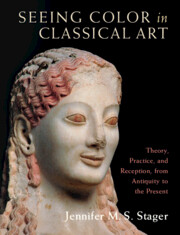Book contents
- Seeing Color in Classical Art
- Seeing Color in Classical Art
- Copyright page
- Dedication
- Contents
- Acknowledgements
- Introduction
- Chapter 1 Material Color, Language, and Khrōma
- Chapter 2 Additive Colors, Kosmēsis, and Care
- Chapter 3 Khōra, Relief, AND Landscape
- Chapter 4 Inlaid Eyes, Effluences, and Opsis
- Chapter 5 Atoms, Lithoi, and Animacy
- Epilogue
- Select Bibliography
- Index
Introduction
Published online by Cambridge University Press: 25 November 2022
- Seeing Color in Classical Art
- Seeing Color in Classical Art
- Copyright page
- Dedication
- Contents
- Acknowledgements
- Introduction
- Chapter 1 Material Color, Language, and Khrōma
- Chapter 2 Additive Colors, Kosmēsis, and Care
- Chapter 3 Khōra, Relief, AND Landscape
- Chapter 4 Inlaid Eyes, Effluences, and Opsis
- Chapter 5 Atoms, Lithoi, and Animacy
- Epilogue
- Select Bibliography
- Index
Summary
For the opening ceremony of the 2004 Olympic Games in Athens, thousands of volunteers painted their faces and costumed their bodies into embodiments of iconic ancient Greek art objects, capturing their vivid colors and patterns (Figures 1 and 2).1 Staged by director Dimitris Papaioannou, Hourglass (Klepsydra) performed a story of ancient Greek art in vividly polychrome living pictures (tableaux vivants). 2 Unlike the bright colors of those portraying objects from earlier and later epochs, however, volunteers portraying the idealized nude male statues and richly clothed female counterparts produced as dedications in the sixth to fifth centuries bce as well as those playing the figures on the reliefs of the Parthenon wore thick white face and body paint, white muscle suits, or white dresses (Figures 3 and 4).3 The construction of these monochrome white sculptural bodies required significant preparation and stood out dramatically on stage in contrast with the colors of earlier and later art bodies.4 This costume of monochrome whiteness thus visually bracketed the living statues portraying the art of the late sixth, fifth century, and early fourth centuries bce from the actors portraying the rest of ancient Greek art.
- Type
- Chapter
- Information
- Seeing Color in Classical ArtTheory, Practice, and Reception, from Antiquity to the Present, pp. 1 - 30Publisher: Cambridge University PressPrint publication year: 2022



